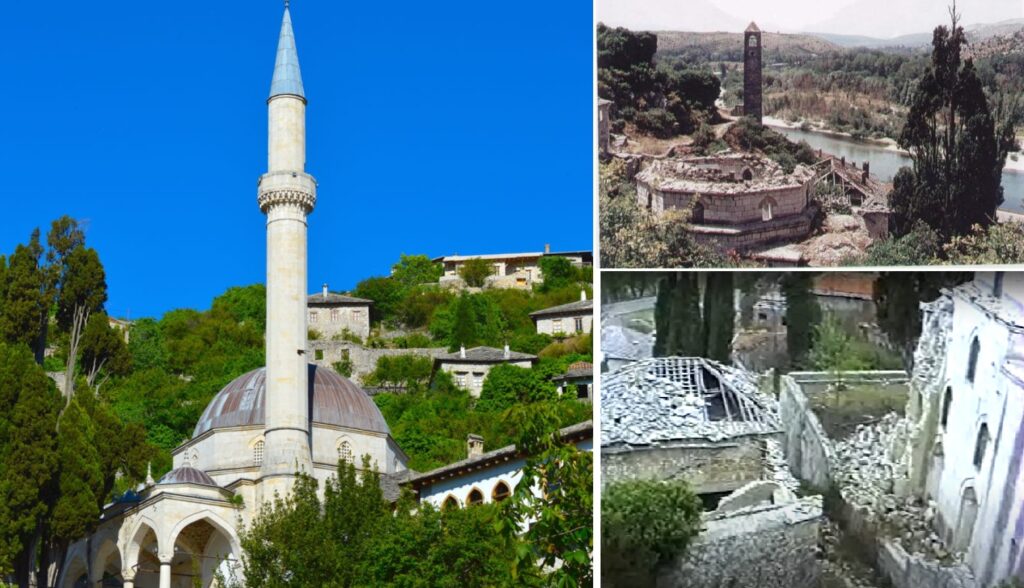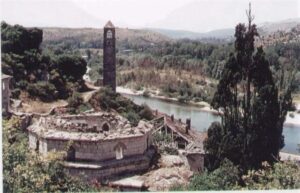
Pocitelj Mosque – Destruction of Many Centuries Old Historic Buildings including Počitelj Mosque
The video was created in April 1997 by Almin Kapetanovic-Coki, who also selected the music. The footage depicts Počitelj in a very ruined state after the HVO’s demolition of the mosque and the devastation of surrounding buildings. In the video you can see Almin Kapetanovic – Coki and Almir Veledar – Aljo. (Almir is owner of Almir bar and Grill in Počitelj, me sure to visit!) The video was intended for a wider audience as a reminder of the events that took place in 1993. The hope is that this video will highlight the inhumanity that occurred during the war and raise awareness among future generations of Bosnia and Herzegovina to prevent anything similar from happening again. Počitelj is a town dominated by oriental architectural styles, with a mix of Mediterranean style, giving this settlement a unique dimension. The town was first mentioned in written documents in 1444 as the seat of the Dubrava parish. It is presumed that the builder of the fortified city and founder of the suburban settlement was the Bosnian King Tvrtko I Kotromanić in 1383. The Ottoman Empire conquered Počitelj in 1471 when it became the seat of the captaincy. During the 17th century, the Pocitelj mosque was restored by Šišman Ibrahim-pasha, and since then, it has been known as Šišman Ibrahim-pasha’s mosque. This is a masterpiece of Ottoman-era architecture.
Počitelj is dominated by oriental architectural styles, which, combined with a mix of Mediterranean influences, give this settlement a unique dimension. It is first mentioned in written documents in 1444 as the seat of the Dubrava parish. It is believed that the fortified town and the founder of the suburban settlement was Bosnian King Tvrtko I Kotromanić in 1383. The Ottomans conquered Počitelj in 1471, making it the center of a captaincy. With the Venetian conquest of Gabela in 1694, Počitelj took over the previous role of being a border center held by Gabela, which it maintained until the 19th century.
Pocitelj Mosque, The Šišman Ibrahim-paša or Hadži Alija Mosque represents one of the most successful examples of the classic Ottoman style of single-dome, semi-dome mosques in Bosnia and Herzegovina. This mosque does not have preserved endowment deeds (vakufname), nor did it have an inscription plaque above the mosque doors until 1948. It was only then that the plaque, which had been previously located inside the mosque, was placed there. The inscription reads: “This honorable mosque was built for the forgiveness of sinners by the benefactor Hadži Alija, son of Musa, in the year 970” (1562-1563). In the 17th century, the mosque was repaired by Šišman Ibrahim-paša, and since then, it has been commonly referred to as Šišman Ibrahim-paša Mosque. It is a masterpiece of architecture from the Ottoman era. The mosque has a dome, and the entrance is grand with beautifully carved wooden doors. The landscape is dominated by a beautiful, slender octagonal minaret with rich decorations, particularly a stalactite frieze below the balcony.
There is no cemetery next to the Pocitelj Mosque, as is customary with other mosques in Bosnia and Herzegovina, because the rugged and narrow terrain did not allow for the creation of a cemetery. The entrance to the mosque is adorned with beautifully carved double-winged doors, above which is a highly decorated portal. In the mosque courtyard, next to the minaret, a special type of cypress tree grows, which is said to be older than the mosque itself, even brought from Lebanon. This exotic plant gives a special touch to the mystical courtyard that you will never find deserted.
Other public buildings located near the mosque include a mekteb (religious school), imaret (public kitchen), medresa (Islamic school), hamam (public bath), han (caravanserai), and clock tower. During the aggression on Bosnia and Herzegovina, in which Počitelj suffered extensive destruction, its mosque was not spared. The mosque was significantly damaged by artillery in 1993 by the Serbian army and shortly after that was mined by the Croatian army. The central dome of the mosque collapsed inside the building due to the explosion, and the walls collapsed almost halfway. The slender minaret, made of hewn stone, was completely demolished. As part of the Permanent Protection Program of Počitelj, the mosque has been restored and has now returned to its original function.
Restored, pictures from our recent trip back home in April 2023. It was very emotional heart warming experience to pray inside. It is beautifully restored.
—————————————————————————————————————————————————————-
Video je nastao u aprilu 1997. godine. Snimatelj je Almin Kapetanovic-Coki koji je odabrao i muziku. Akteri na video-snimku su Almin Kapetanovic – Coki i Almir Veledar – Aljo. Video je namijenjen široj publici kao podsjetnik na dešavanja iz 1993. godine. Na snimku se vidi Počitelj u veoma ruševnom stanju nakon HVO-og miniranja džamije i devastacije okolnih objekata. U periodu od miniranja džamije u ljeto 1993. godine, pa do nastanka ovog snimka, Počitelj je doživio protjerivanje stanovništva, krađu umjetničkih slika iz umjetničke kolonije međunarodnog značaja, čupanje instalacija iz zidova, skidanje greda sa kuća, te uništavanje svega sto je imalo bilo kakve veze s islamom i osmanskom kulturom. Nadamo se da će ovaj video ukazati budućim naraštajima zemlje Bosne i Hercegovine na nečovječnosti koje su se dešavale u minulom ratu i osvijestiti ih da spriječe da se nešto slično više nikada ne ponovi.
Počiteljem dominiraju orijentalni građevinski stilovi, koji sa mješavinom mediteranskog stila daju ovom naselju jednu posebnu dimenziju. Prvi put se spominje u pisanim dokumentima 1444.godine, kao sjedište župe Dubrava. Pretpostavlja se da je graditelj utvrđenog grada i osnivač prigradskog naselja bio bosanski kralj Tvrtko I Kotromanić 1383.godine. Osmanlije osvajaju Počitelj 1471.godine, kada postaje sjedište kapetanije. Mletačkim osvajanjem Gabele 1694.godine, dotadašnju ulogu pograničnog centra, koju je imala Gabela, preuzima Počitelj i zadržava je do 19.stoljeća. Šišman Ibrahim-pašina ili Hadži Alijina džamija predstavlja jedno od najuspješnijih osvarenja klasičnog osmanskog stila jednoprostornih potkupolnih džamija u BiH. Ova džamija nema sačuvane vakufname, niti je u udubini za natpis iznad džamijskih vrata stajala ranije natpisna ploča. Tek 1948 g. postavljena je ovdje natpisna ploča koja je do tada stajala u džamiji: „Ovaj časni mesdžid sagradi za oprost griješnika dobrotvor Hadži Alija sin Musa-ov godine 970“ (1562-63). U XVII stoljeću džamiju je opravljao Šišman Ibrahim-paša, te od tada u narodu nosi naziv Šišman Ibrahim-pašina džamija. Riječ je o majstorskom remek-djelu arhitekture osmanskog doba. Džamija je pod kupolom, ulaz je monumentalan s prekrasnim vratima u drvetu rezbarenim. Krajolikom dominira krasna, vitka osmougaona munara s bogatim ukrasima, naročito stalaktitnim nizom ispod šerefe. Uz počiteljsku džamiju nema nikakvog groblja kao što je obično kod drugih džamija u Bosni i Hercegovini, jer tvrd i skučen teren nisu dozvolili nastajanje harema. Ulaz u džamiju krase veoma lijepa rezbarena dvokrilna vrata iznad kojih se nalazi veoma dekorisan portal. U džamijskoj avliji, pored munare raste i drvo, posebna vrsta čempresa, za koji se tvrdi da je stariji od same džamije, donesen čak iz Libana. Ta egzotična biljka daje poseban ton mističnom dvorištu koje nikad nećete zateći pusto. Ostale javne zgrade smještene uz džamiju su mektebi, imaret, medresa, hamam, han i sat-kula. Tokom agresije na Bosnu i Hercegovinu, u kojem je Počitelj pretrpio velika razaranja, nije pošteđena bila ni njegova džamija. Džamija je artiljerijom znatno oštećena 1993. godine od strane srpske vojske, a nedugo zatim je i minirana od strane Hrvatske vojske. Od eksplozije centralna džamijska kupola urušila se u unutrašnjost zdanja, a zidovi su se skoro do polovine obrušili. Vitka munara, od klesanog kamena, srušena je do temelja… Kao dio Programa stalne zaštite Počitelja, džamija je sanirana i sada se vratila svojoj izvornoj funkciji.











Pingback: Počitelj Kula Roof Restoration - Friends of Počitelj